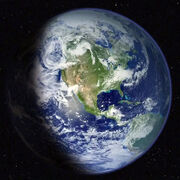
The Minshara class planet Earth
In the Federation standard system of planetary classification a class M planet or planetoid was considered to be suitable to humanoid life. It was generally characterized by an abundance of surface water and an atmosphere high in nitrogen, oxygen and trace elements. Life was often abundant on class M planets; they contained extensive vegetation, animal life, and often had native humanoids. However, life was always Carbon-based. (ENT: "Observer Effect")
During the mid-22nd century, Vulcan science used the term Minshara class for such planets. Vulcans were not able to determine if a planet was Minshara class through orbital scans, instead sending down probes to collect the necessary data. (ENT: "Strange New World"). While in 2151 Starfleet officers were not familiar with the term, Enterprise chose to adopt the term. However, by 2154, Earth Starfleet had adopted the term Class M. A century later the term was in general use in the Federation's Starfleet, even though the term "Earth-type" was also occasionaly used.
By the 23rd century it was theorized that there was a mathematical probability of three million Earth-type planets in the Milky Way Galaxy alone. (TOS: "Balance of Terror")
| Planetary classification |
|---|
| B • D • G • H • J • K • L • M • N • R • T • Y • Other classes |
Appendices
Background information
- The term "class M" was first used in "The Cage" to describe the planet Talos IV. The variant "M class" is also often used. The term has become Star Trek shorthand for Earthlike, and due to obvious production practicalities is the "default" for planetary surface scenes.
- The Vulcan term Minshara class (first used in ENT: "Strange New World") was used in Enterprise to denote planets that in other series would have been called class M by the writers, the implied consequence being that the two terms meant the same, and possibly even that M stood for Minshara. This assumption has been contested by some fans, but is at least supported by the Star Charts. From an in-universe standpoint The term M-class was first heard chronologically in ENT: "Home", where Archer used it to describe Archer IV, a planet implied (but not confirmed) to be Minshara class in ENT: "Strange New World".
- Spock called the planet from TOS: "Return to Tomorrow" class M despite the atmosphere being ripped away, suggesting that class M goes beyond being able to support life. Alternately, he could have been saying that the planet prior to losing its atmosphere would have been categorized as class M.
- According to the Star Trek: Star Charts, class M planets have ages that range from three to ten billion years and a diameter between 10,000 and 15,000 kilometers. They are located within the ecosphere of a star system.
Apocrypha
- The novel Strangers from the Sky indicates that the term "Class M" was used by Humans prior to First Contact with Vulcans, or indeed before humanity reached any extra-solar planets.
External link
- Template:NCwiki
